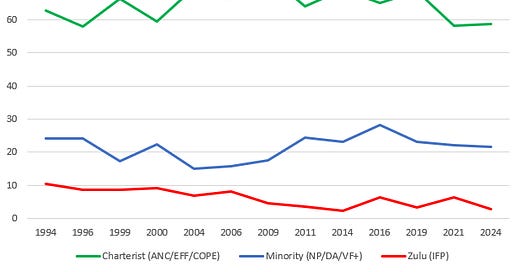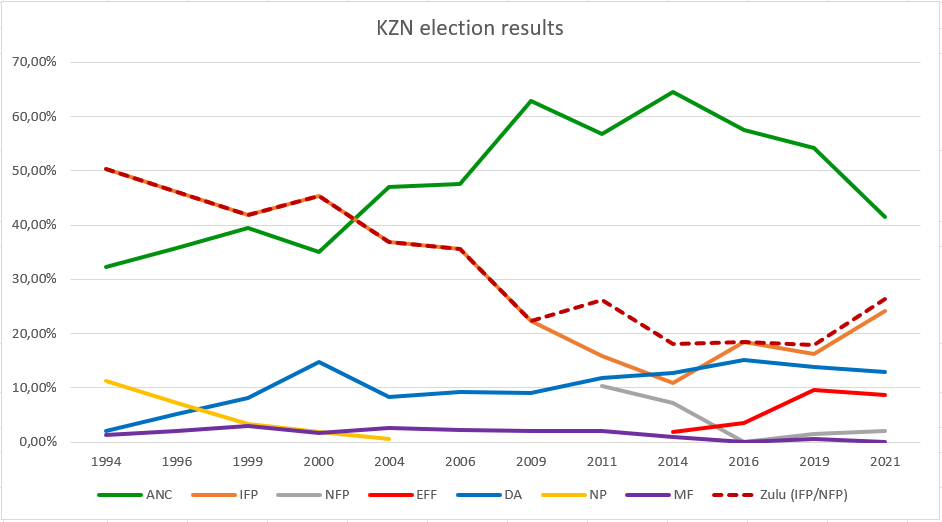South Africa: Ethnodemocracy
South Africa has always voted along ethnic lines, and does moreso every day.
Our country votes according to race. The evidence is inescapable. Cross-racial voting patterns are very limited, and what change has come has resulted from weakening or fracturing racial coalitions within parties, and only to a lesser degree from nonracial voting patterns.
National trends
The DA have passed their peak, and the ANC have been on a steady decline for years now. The ANC and the EFF have both seen their support fall in recent months, in a way that is outside their usual envelope, but only by a little.
The voting population has been staying away from the polls in greater proportions with each election. Whites vote more than other groups, often by as much as a 2-1 margin (unfortunately that racial breakdown is unpublished research, so you’ll have to trust me, I’m afraid).
The DA are in fact the most competent of the top three major parties (ANC, DA, EFF). They are the least corrupt of this set as well. They also hold many talented people, who are even allowed to do their jobs with relative freedom. But that’s sort of winning by default, since the ANC really is among the worst humanity has to offer.
But the DA’s shortcomings are for the next post. Substack has content limits that my graphs are eating up.
The following graph shows current major parties’ representation over the past 30 years. The ANC is charted on the right-hand side (dotted line), because their size compresses the other results and makes them illegible. The 2024 result is an average of all the available public opinion polls, but should be taken with the caveat that previous general election polls have underestimated the ANC’s share by between 2-3%.
These 2024 polls show the ANC at 47,4%; DA at 19,9% and EFF at 11,3%. I had to plot the ANC on the right-hand side, because they so dominate the graph that otherwise it would be difficult to see the others.
What is immediately apparent, is that the parties representing minorities’ interests add up to around 25% of the vote, and have remained capped by that ceiling since 1994. The DA absorbed the NP’s old base, and hasn’t exceeded their 1994 performance by any significant margin since then. The ANC has seen their support eaten up mostly by the IFP and EFF, with only a trickle going to the DA, which appears to stabilise around 20%, seeing a threat only from other minority-interest parties.
Provincial trends
At the provincial level, we see a similar phenomenon to the whole. Most provinces are quite simply black-vs-minority split, with the exception of the Northern and Western Cape, KwaZulu Natal and Gauteng. But the NC is nonetheless rather dull to look at, so I just made graphs for the three economic hub provinces.
KZN’s minority ceiling is at around 10-12%. But they have Zulu nationalists in the IFP, which collasped with the rise of Jacob Zuma, and was split with the arrival of the NFP, a sort of ANC puppet project, I gather. Zulu nationalist party total represented by the dotted line.
Gauteng is more like the nation as a whole, but with more black liberals, perhaps the only major constituency (there a few minor ones) with noticeable cross-racial voting patterns. Whites are 15.6%, Coloureds 3.5%, Indians 3%, totalling 22%. The DA peaked at 35%.
Now for the Western Cape, I summed up the results of the Coloured identity parties led by Patricia de Lille, Gayton MacKenzie and Fadiel Adams, and summed up the ANC and EFF. The 1996 local election results were not available in aggregate for the province, and the NP and VF+ didn’t show in local elections for a couple of years, so I took averages of the national election results of neighbouring years to fill the gaps and produce contiguous lines. Polls are not available for 2024 at the provincial level.
As the wheels have started to come off more rapidly after hope for reform (Ramaphoria) has finally died, the ethnic divides have gotten deeper. But the effects of these intra-racial competitions are only visible at finer-grained analysis, and the emerging trend of ethnic consolidation can only be seen in by-election results.
Fortunately, Dawie Scholtz has done us a big favour these past few years by obsessively tracking local by-election trends. His last collective findings were published by News24 end of last year, with some interesting results:
The rest of that article linked above shows two other trends - black wards outside KwaZulu Natal are increasingly leaning to the EFF (black identity), while within KZN, they are leaning toward the IFP (Zulu identity). What is happening here, is that, much like the rest of the country, the DA is being concentrated down to its ethnic core - Anglos.
What has happened here, as far as I can gather, is that having become frustrated at the lack of progress in pushing against the great ebony ceiling, minority voters are looking to fix things by wresting power from within the minority party bloc.
It’s not a terrible strategy, all things considered, since the only way in which things have really changed recently is the shifts within these ethnic camps, such as the arrival of the EFF, and the recent emergence of non-Anglo minority representation and Cape secessionism, which has pushed the DA towards actually fulfilling some of their manifesto promises regarding devolution and federalism to contain it.
I will have to talk about why these people are so frustrated in the next article, because the whole thing eventually exceeded Substack’s word limit, and last time I did that the site crashed trying to publish it.












Good read, I wonder what ActionSA's stats look like